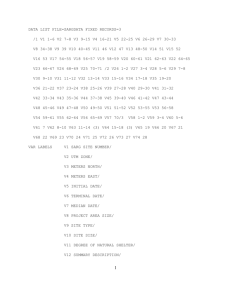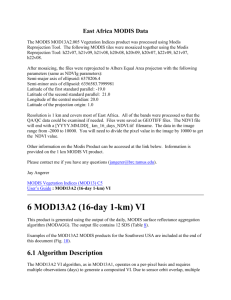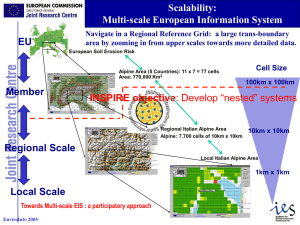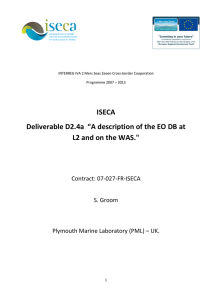USING THE DATA FUSION TECHNIQUE FOR PRODUCING THEMATIC MAP
advertisement
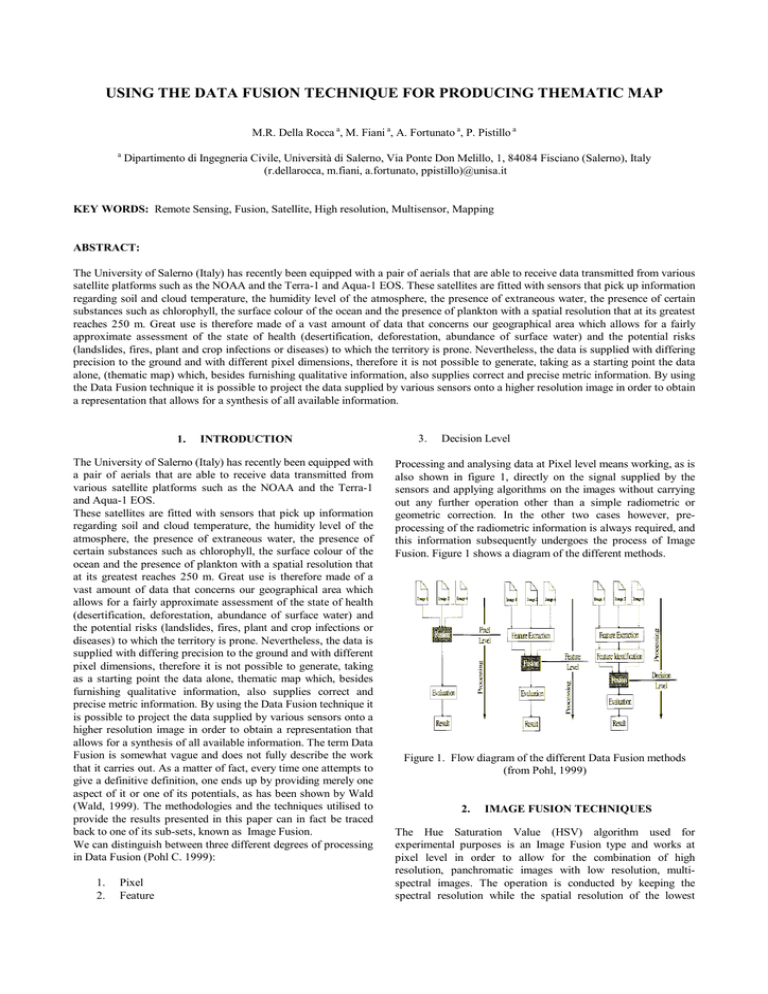
USING THE DATA FUSION TECHNIQUE FOR PRODUCING THEMATIC MAP M.R. Della Rocca a, M. Fiani a, A. Fortunato a, P. Pistillo a a Dipartimento di Ingegneria Civile, Università di Salerno, Via Ponte Don Melillo, 1, 84084 Fisciano (Salerno), Italy (r.dellarocca, m.fiani, a.fortunato, ppistillo)@unisa.it KEY WORDS: Remote Sensing, Fusion, Satellite, High resolution, Multisensor, Mapping ABSTRACT: The University of Salerno (Italy) has recently been equipped with a pair of aerials that are able to receive data transmitted from various satellite platforms such as the NOAA and the Terra-1 and Aqua-1 EOS. These satellites are fitted with sensors that pick up information regarding soil and cloud temperature, the humidity level of the atmosphere, the presence of extraneous water, the presence of certain substances such as chlorophyll, the surface colour of the ocean and the presence of plankton with a spatial resolution that at its greatest reaches 250 m. Great use is therefore made of a vast amount of data that concerns our geographical area which allows for a fairly approximate assessment of the state of health (desertification, deforestation, abundance of surface water) and the potential risks (landslides, fires, plant and crop infections or diseases) to which the territory is prone. Nevertheless, the data is supplied with differing precision to the ground and with different pixel dimensions, therefore it is not possible to generate, taking as a starting point the data alone, (thematic map) which, besides furnishing qualitative information, also supplies correct and precise metric information. By using the Data Fusion technique it is possible to project the data supplied by various sensors onto a higher resolution image in order to obtain a representation that allows for a synthesis of all available information. 1. INTRODUCTION The University of Salerno (Italy) has recently been equipped with a pair of aerials that are able to receive data transmitted from various satellite platforms such as the NOAA and the Terra-1 and Aqua-1 EOS. These satellites are fitted with sensors that pick up information regarding soil and cloud temperature, the humidity level of the atmosphere, the presence of extraneous water, the presence of certain substances such as chlorophyll, the surface colour of the ocean and the presence of plankton with a spatial resolution that at its greatest reaches 250 m. Great use is therefore made of a vast amount of data that concerns our geographical area which allows for a fairly approximate assessment of the state of health (desertification, deforestation, abundance of surface water) and the potential risks (landslides, fires, plant and crop infections or diseases) to which the territory is prone. Nevertheless, the data is supplied with differing precision to the ground and with different pixel dimensions, therefore it is not possible to generate, taking as a starting point the data alone, thematic map which, besides furnishing qualitative information, also supplies correct and precise metric information. By using the Data Fusion technique it is possible to project the data supplied by various sensors onto a higher resolution image in order to obtain a representation that allows for a synthesis of all available information. The term Data Fusion is somewhat vague and does not fully describe the work that it carries out. As a matter of fact, every time one attempts to give a definitive definition, one ends up by providing merely one aspect of it or one of its potentials, as has been shown by Wald (Wald, 1999). The methodologies and the techniques utilised to provide the results presented in this paper can in fact be traced back to one of its sub-sets, known as Image Fusion. We can distinguish between three different degrees of processing in Data Fusion (Pohl C. 1999): 1. 2. Pixel Feature 3. Decision Level Processing and analysing data at Pixel level means working, as is also shown in figure 1, directly on the signal supplied by the sensors and applying algorithms on the images without carrying out any further operation other than a simple radiometric or geometric correction. In the other two cases however, preprocessing of the radiometric information is always required, and this information subsequently undergoes the process of Image Fusion. Figure 1 shows a diagram of the different methods. Figure 1. Flow diagram of the different Data Fusion methods (from Pohl, 1999) 2. IMAGE FUSION TECHNIQUES The Hue Saturation Value (HSV) algorithm used for experimental purposes is an Image Fusion type and works at pixel level in order to allow for the combination of high resolution, panchromatic images with low resolution, multispectral images. The operation is conducted by keeping the spectral resolution while the spatial resolution of the lowest The International Archives of the Photogrammetry, Remote Sensing and Spatial Information Sciences, Vol. 34, Part XXX precision data is increased. In this way one is able to make use of the same information obtained before processing but at a greater degree of resolution. Before applying this method however, it is necessary to correct radiometrically and to geo-reference the images in order to make the relationship between the single pixels univocal (figure 2). If however the data has the same spatial resolution, a simple co-recording can be carried out. This procedure allows for an orientation of one of the two images in relation to the other, independently of the reference system in which the data is furnished. HSV allows merging of RGB type images with panchromatic images, therefore only a limited number of bands (three with this method) may be employed. The different sensor channels are therefore associated with the three basic colours in order to generate an false colours image representing a physical reality, such as might be, for example, temperature distribution in the upper atmosphere or the rate of ground level humidity. This operation requires a good knowledge of the data one wishes to use and great care in the choice of bands to associate with the three RGB channels. The principle on which this algorithm is based is to separate and extrapolate, starting from the false colour image, the information relating to the intensity (I) to the saturation (S) and to the hue (H). From a strictly mathematical point of view, the system of coordinates (I, S, H) can be thought of as an Cartesian orthogonal system; given that the human eye treats the three components as if they were bound by an orthogonal type relationship (Bretschneider and Kao, ), and can be written (Pohl, 1998) as follows: I V 1 V2 = 1 1 3 1 3 1 6 1 6 −1 2 2 1 R G B = 1 1 1 3 1 6 1 3 1 6 −2 3 6 2 I − 1 V1 2 V2 0 (2) Before starting transformation (2), the information regarding saturation and colour (S, H) is opportunely re-sampled by using linear type techniques and stretching techniques in order to adapt the multi-spectral bands to the band furnished by the highest resolution panchromatic sensor. HSV, therefore, is an evolution of the IHS algorithm, which has now become a standard in the procedure of Image Analysis. 3 R − 2 G 6 B 0 Figure 2. Flow diagram of operations 3. SENSORS UTILISED (1) −1 V H = tan 1 V2 S= (V1 )2 + (V2 )2 The variables V1 and V2 are only and exclusively used to calculate H and S and have no direct connection to the image. The first of the three coordinates, that represents the intensity (I), is directly related to spatial position in that its value is bound to the type of surface analysed, while the coordinates H and S supply additional radiometric information by describing its composition and degree of absorption. In figure 2 the sequence of operations to be carried out is shown synthetically. Once the information is deconstructed, it is possible to substitute one of the three components with the information contained in a fourth channel, which has not undergone any kind of transformation. Generally it is the I component to be substituted with the intensity value obtained from the higher resolution image. Once this operation is completed, one proceeds to invert transformation (1) so as to obtain again an RGB type image. The formula that allows for such a passage is the following: The MODIS sensor (Moderate-resolution Imaging Spectroradiometer), was installed by NASA, together with other typologies of instruments, for the analysis of the atmosphere, the oceans and land above sea level on Terra and Aqua launched respectively in 1999 and 2001. These are two of the most used satellites for global monitoring of the environment. Figure 3 shows the diagram of the MODIS sensor. MODIS is a spectrometer capable of observing the Earth, with a return period equal to 1 – 2 days and using 36 channels (see table 4). The spectral bands utilised are included between 0.45 and 14.4 µm (21 bands included in the interval of 0.45-3.0 µm, 15 included in the interval of 3.0-14.4 µm) and furnish a spatial resolution at the nadir, depending on the band, of 250 m, 500 m and 1 Km. Thanks to the high number of channels and to short employment frequency, this sensor is used for various applications, among which the following: - Determining different scales of cloud cover Assessing Aerosol concentration Assessing plant cover and soil productivity Estimating snow masses Measuring soil temperature Monitoring fires The International Archives of the Photogrammetry, Remote Sensing and Spatial Information Sciences, Vol. 34, Part XXX Figure 3. Diagram of the MODIS sensor Channel Wavelength Spectrum Primary Use 1 2 3 4 5 6 7 8 9 10 11 12 13 14 15 16 17 18 19 20 21 22 23 24 25 26 27 28 29 30 31 32 33 34 35 36 0.620-0.670µm 0.841-0.876µm 0.459-0.479µm 0.545-0.565µm 1.230-1.250µm 1.628-1.652µm 2.105-2.155µm 0.405-0.420µm 0.438-0.448µm 0.483-0.493µm 0.526-0.536µm 0.546-0.556µm 0.662-0.672µm 0.673-0.683µm 0.743-0.753µm 0.862-0.877µm 0.890-0.920µm 0.931-0.941µm 0.915-0.965µm 3.660-3.840µm 3.929-3.989µm 3.929-3.989µm 4.020-4.080µm 4.433-4.498µm 4.482-4.549µm 1.360-1.390µm 6.535-6.895µm 7.175-7.475µm 8.400-8.700µm 9.580-9.880µm 10.78-11.28µm 11.77-12.27µm 13.18-13.48µm 13.48-13.78µm 13.78-14.08µm 14.08 14.38µm Visible near IR Visible Visible near IR near IR near IR Visible Visible Visible Visible Visible Visible Visible Visible near IR near IR near IR near IR thermal IR thermal IR thermal IR thermal IR thermal IR thermal IR near IR SWIR SWIR SWIR SWIR LWIR LWIR LWIR LWIR LWIR LWIR 0.25km 0.25km 0.5km 0.5km 0.5km 0.5km 0.5km 1km 1km 1km 1km 1km 1km 1km 1km 1km 1km 1km 1km 1km 1km 1km 1km 1km 1km 1km 1km 1km 1km 1km 1km 1km 1km 1km 1km 1km Figure 5. Diagram of the AVHRR sensor The latest version of the AVHRR features six spectral bands (table 6): one in the visible spectrum (B1, 580-680 nm), three in the near and medium infrared spectrum (B2, 0.725-1.1 µm; B3a, 1.58-1.64 µm; B3b, 3.55-3.93 µm) and two in the thermal infrared spectrum. The sensor is able to acquire data on a daily basis at a resolution of 1.1 Km, allowing for monitoring on a global scale of the oceans and land above sea-level. By using the data from AVHRR it has been possible to construct global vegetation maps, investigate models of ocean current circulation and analyse fires on a global scale. Channel Wavelength Spectrum Primary Use B1 B2 B3a B3b B4 B5 0.58-0.68µm 0.725-1.10µm 1.58-1.64µm 3.55-3.93µm 10.3-11.3µm 11.5-12.5µm Visible near IR near IR medium IR thermal IR thermal IR 1.1km 1.1km 1.1km 1.1km 1.1km 1.1km Table 6. AVHRR sensor channels By observing the diagrams in Figure 7 and 8 and the tables 4 and 6, it can be noted that the MODIS and AVHRR multi-spectral sensors are capable of covering a large portion of the electromagnetic spectrum. Table 4. MODIS sensor channels The Advanced Very High Resolution Radiometer (AVHRR), the predecessor of the MODIS, is an instrument that was designed and put into orbit on behalf of the National Oceanic and Atmospheric Administration (NOAA). Originally intended for meteorological analysis, since its launch it has been used for environmental applications such as the analysis of temperature cycles of the surface of the sea and for monitoring Earth’s vegetation on a global scale. The first sensor was launched in 1979 on board of the first NOAA satellite and this was followed with the launch of numerous satellites, the last of which was the NOAA-16 in September 2000. The sensor supplies multispectral images with a swath of a little over 2600 Km per FOV equal to ±56° and capable of supplying data with a high temporal frequency since the NOAA has an orbit of LEO polar orbits type at a nominal altitude of 833 Km. Figure 5 shows a diagram of the AVHRR sensor. Figure 7. Graph of atmospheric absorption for high wavelengths (from Hyvarinen, 2000) The International Archives of the Photogrammetry, Remote Sensing and Spatial Information Sciences, Vol. 34, Part XXX Figure 8. Graph of atmospheric absorption for low wavelengths (from Hyvarinen, 2000) 4. PRODUCING THEMATIC MAPS The data received from different sensors have different spatial resolutions and it is difficult to solve problems of practical interest only with data coming from a single band permit to solve. Thus comes about the necessity of succeeding in combining information supplied by different channels in order to obtain thematic maps which allow for monitoring and evaluation of the differing aspects of a given phenomenon. The HSV algorithm, described in paragraph 2, allows for “merging” information supplied by different channels without however altering its radiometric characteristics. The results obtained therefore will be higher spatial resolution images than the input data and will no longer contain single band information but the combined data coming from three different channels. Combining the information occurs through the use of false colour images, as was also proposed by Karlsson (Karlsson, 1997). Each of the three basic colours (Red, Green and Blue) is assigned a different channel. The results of the experimentation described in this study were obtained by combining the different channels of the MODIS sensor (Hyvarinen, 2000), and using software ENVI ver 4.0. Figure 9a shows the image obtained from the combination of bands 1, 4, 3, that correspond respectively to the frequencies of Red, Green and Blue, with which it is possible to obtain a True Figure 9a. True Color MODIS (500m) Colors image of the imaged area with nominal precision of 500 m. Figure 9b however, was obtained by using the HVS algorithm to merge the preceding bands with band 2, in order to obtain ground level precision equal to 250 m. The images in figures 10a and 11a, respectively combinations of channels 7, 4, 3 and 7, 2, 1, also have spatial precision equal to 500 m, while the images in figures 10b and 11b, which were obtained through Image Fusion, have a spatial resolution of 250 m. Projecting the images shown in figures 10b and 11b onto channel 2, at a higher resolution, allows for a more accurate analysis of the spread and health of woodland areas. In fact, in figure 10b, the lighter red areas show areas of healthy vegetation while the areas in darker red are areas in which there is no or diminishing amounts of vegetation. This type of representation allows us to gain an idea of the distribution and the development of areas in the process of desertification and also gives us more detailed information on the typology of vegetation present. The images obtained from the sensors mounted on the Terra and Aqua satellites not only supply useful information for territorial analysis but also allow for analysis and study of Earth’s atmosphere, as shown in the images in figures 12a and 13a (obtained by combining channels 20, 31, 32 and 1, 6, 31 of MODIS). In figure 12b it can be seen how it is possible to easily identify the different typologies of clouds, their different altitudes and, in the case of snow, its spread over an area of land. The data shown in the image in figure 13b allows for an assessment of the presence of water vapour in the atmosphere and thus facilitates the determination of those areas at risk from fog. The same results presented in the last figures were also obtained by combining channels 3, 4, 5 and 1, 3, 4 of the AVHRR sensor that correspond to channels (20, 31, 32) and (1, 6, 31) of the MODIS sensor. In this case it was passed from a spatial resolution of 1Km (figs. 14a) to one of 250 m (figs. 14b). Information can moreover be synthesized using a thematic map that shows in a clear way areas with a presence of vegetation. Ad example of this representation is in figure 15 where the blue zones are areas with a large wooded presence. This result is obtained automatically with the classification algorithm K-Means, already implemented in ENVI. Figurae 9b. True Color MODIS (250) The International Archives of the Photogrammetry, Remote Sensing and Spatial Information Sciences, Vol. 34, Part XXX Figure 10a. Index of desertification. MODIS (500m) Figure 10b. Index of desertification MODIS (250m) Figure 11a. Index of vegetation MODIS (500m) Figure 11b. Index of vegetation MODIS (250m) Figure 12a. High altitude clouds MODIS (1 km) Figure 12b. High altitude clouds MODIS (250m) Figure 13a. High altitude clouds MODIS (1 km) Figure 13b. High altitude clouds MODIS (250m) The International Archives of the Photogrammetry, Remote Sensing and Spatial Information Sciences, Vol. 34, Part XXX Figure 14a. High altitude clouds NOAA (1 Km) Figure 14b. High altitude clouds NOAA (250 Km) Bretschneider, T., Kao, O. 2000. Image Fusion in Remote Sensing. In: On line Symposium for Electronics Engineers, Clausthal, Germany. http://www.erc.msstate.edu/~veera/ImageQualityMetrics/Literat ure/OSEE2000.pdf (accessed 29 Apr. 2004) Carper, W. J., Lillesand, T. M., Kiefer, R. W., 1990, The Use of Intensity-Hue-Saturation Transformation for Merging SPOT Panchromatic and Multi-spectral Image Data. Photogrammetric Engineering and Remote Sensing, 56,pp. 459-467. Hall, D.K., Riggs, G.A., Salomonson, V., Di Girolamo, N., Bayr, K.J., 2000. MODIS snow-cover products. Remote Sensing of Environment, 83, pp. 181-194. Figure 15. Map of vegetation distribution 5. CONCLUSIONS Data Fusion is a technique, which allows to obtain results that are of great scientific interest as long as the structure and the characteristics of the data utilised are well known. Furthermore, the results of the “fusion” operation are strongly influenced by the type of pre-processing, by the processing technique employed and by the temporal range of the data used. This consideration may seem banal but we think about it was important to stress the fact that, particularly when using data coming from different sensors, which often happens, an inadequate pre-processing of the data does not allow for, for example, a precise correspondence between “homologous” pixels. Finally it should be pointed out that, in the case in which the data used presents an extremely high spatial difference, it is possible that the result obtained by the Image Fusion technique will not provide a good end-product, introducing high deformation of the re-sampled data and furnishing almost illegible results. REFERENCES : Ackerman, S.A., Strabala, K.I., Menzel, W.P., Frey, R.A., Moeller, C.C., Gumley, L.E., 1998. Discrimination clear sky from clouds with MODIS. Journal of Geophysical Research, 103, pp. 32-157. Hyvarinen, O.., 2003. Visualization of MODIS images for duty forecasters. In: 2003 EUMETSAT Meteorological Satellite Conference, Weimar, Germany, pp.452,458. Karlsson, K.G., 1997. An Introduction to Remote Sensing in Meteorology. Swedish Meteorological and Hydrological Institute, ISBN 91-87996-08-1. Qu, J., Chao, W. 2001. A Wavelet Package – Based Data Fusion Method for Multitemporal Remote Sensing Image Processing. In: 22nd Asian Conference on Remote Sensing, Singapore. Pohl, C., Van Genderen, J.L., 1998. Multisensor image fusion in remote sensing: concepts, methods and application. International Journal of Remote Sensing , 5(19), pp. 823-854. Pohl, C., 1999. Tools and methods for fusion of images of different spatial resolution. In: International Archives of the Photogrammetry, Remote Sensing, Valladolid, Spain, Vol. XXXII, Part 7-4-6 W6. Wald, L., 1999. Definitions and terms of reference in data fusion. In: International Archives of the Photogrammetry, Remote Sensing, Valladolid, Spain, Vol. XXXII, Part 7-4-6 W6.

